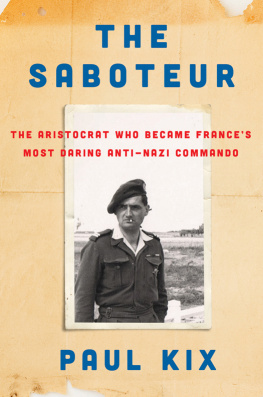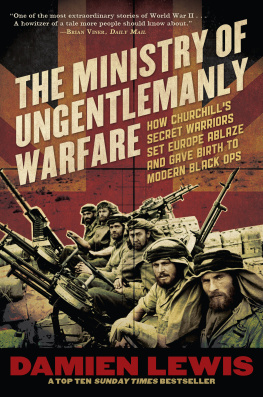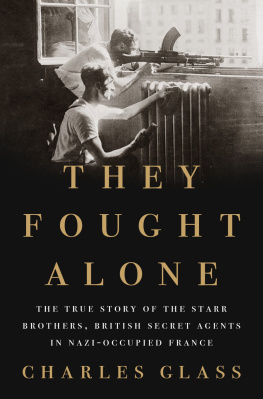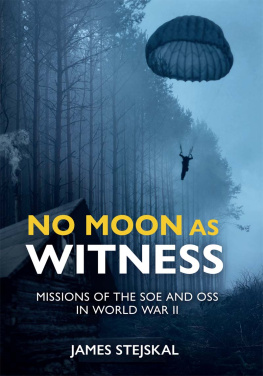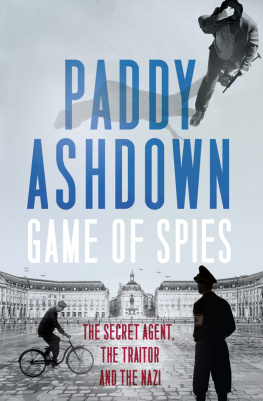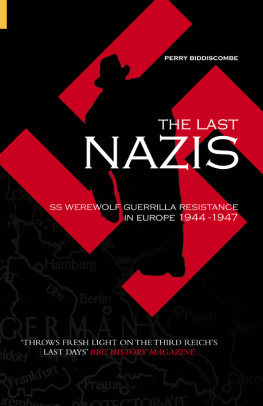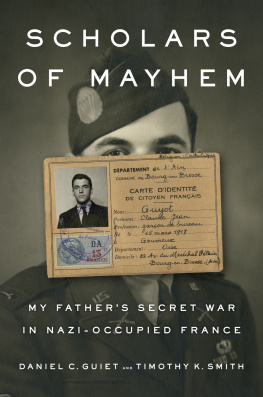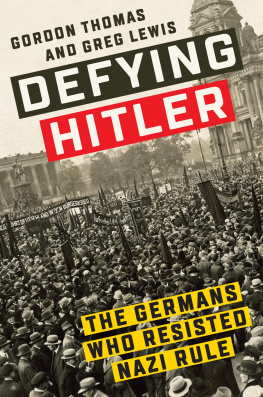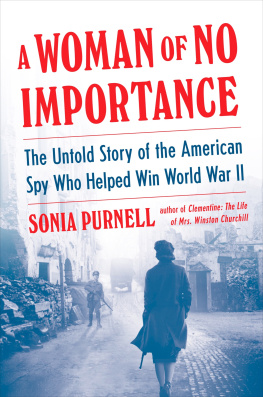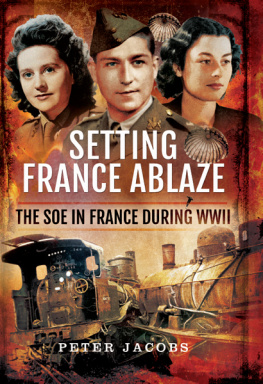For Sonya, as always
T his is a work of narrative nonfiction, meant to relay what it was like for Robert de La Rochefoucauld to fight the Nazis from occupied France as a special operative and rsistant. I relied on a few primary sources to tell this story, most notably La Rochefoucaulds memoir, La Libert, Cest Mon Plaisir: 19401946, published in 2002, a decade before his death. La Rochefoucaulds family, ever gracious, also gave me a copy of the audio recording in which Robert recounted his war and life for his children and grandchildren. This was great source material, as was a DVD I received, which was directed, edited, and produced by one of Roberts nephews, and which tells the tale of his storied family, specifically his parents, his nine brothers and sisters, and the courage that Robert himself needed to fight his war. The DVD, like the audio recording, was made for the La Rochefoucauld family to share with successive generations, but Roberts daughter Constance was kind enough to make me a copy.
I spoke with her and her three siblings at length about their fatherin person, over Skype, on the telephone, and by email. I kept contacting them long after I said I would, and kept apologizing for it. But Astrid, Constance, Hortense, and Jean were always amenable and happy to share what they knew. Im eternally grateful.
This narrative is the result of four years of work, with research and reporting conducted in five countries. I talked with dozens of people, read roughly fifty books, in English and French, and parsed thousands of pages of military and historical documents, in four languages. Despite all this, and no doubt because of the secret nature of La Rochefoucaulds work, there are certain instances where Roberts account of what happened is the best and sometimes only account of what happened. Thankfully, in those spots, Roberts recollections are vivid and reflect the larger historical record of the region and time.
PAUL KIX, JANUARY 2017
H is family kept asking him why. Why would a hero of the war align himself with one of its alleged traitors? Why would Robert de La Rochefoucauld, a man who had been knighted in Frances Legion of Honor, risk sullying his name to defend someone like Maurice Papon, who had been charged, these many decades after World War II, with helping the Germans during the Occupation?
The question trailed La Rochefoucauld all the way to the witness stand, on a February afternoon in 1998, four months into a criminal trial that would last six, and become the longest in French history.
When he entered the courtroom, La Rochefoucauld looked debonair. His silver hair had just begun to recede, and he still swept it straight back. At seventy-four, he carried the dignified air of middle age. He had brown eyes that took in the world with an ironic slant, the mark of his aristocratic forebears, and a Roman, ruling-class nose. His posture was tall and upright as he walked to the stand and gave his oath and, lowering himself to his seat at the center of international attention, he appeared remarkably relaxedhis complexion even had a bronze tint, despite the bleak French winter. He remained a handsome man, nearly as handsome as hed been in those first postwar years, when hed moved from one girl to the next, until hed met Bernadette de Marcieu de Gontaut-Biron, his wife and mother of his four children.
On the stand, La Rochefoucauld wore a green tweed check jacket over a light blue shirt and a patterned brown tie. The outfit suited the country squire, whod traveled to Bordeaux today from Pont Chevron, his thirty-room chateau overlooking sixty-six acres in the Loiret department of north-central France. He radiated a charisma that burned all the brighter when set against the gray sobriety of the courthouse. La Rochefoucauld looked better than anyone in the room.
A reputation for bravery preceded him, and almost out of curiosity for why someone like La Rochefoucauld would defend someone like Papon, the court allowed him an opening statement. La Rochefoucauld nodded at the defendant, who sat in a dark suit behind bulletproof glass. The makings of wry exasperation curled La Rochefoucaulds lips as he recalled events from fifty years earlier.
First, I would like to say that in 1940, although I was very young, I was against the Germans, against Ptain and against Vichy. I was in favor of the continuation of the war in the South of France and in North Africa. He was sixteen then, and came from a family that despised the Germans. His father, Olivier, a decorated World War I officer whod re-enlisted in 1939, was arrested by the Nazis five days after the Armistice in part because hed tried to fight beyond the agreed-to peace. His mother, Consuelo, who ran a local chapter of the Red Cross, was known to German officers as the Terrible Countess. On the stand, La Rochefoucauld skipped over almost all of what happened after 1940, the acts of bravery that had earned him four war medals and a knighthood. He instead focused his testimony on one episode in the summer of 1944 and experiences that greatly compromised the allegations against Papon.
Maurice Papon had been an administrator within the German-collaborating Vichy government. He rose to a position of authority in the Gironde department of southwestern France, whose jurisdiction included Bordeaux. The charge against Papon was that from his post as general secretary of the Gironde prefecture, overseeing Jewish affairs, he signed deportation papers for eight of the ten convoys of Jewish civilians that left for internment camps in France, and ultimately the concentration camps of Eastern Europe. In total, Vichy officials in the Gironde shipped out 1,690 Jews, 223 of them children. Papon had been indicted for crimes against humanity.
The reality of Papons service was far messier than the picture the prosecutors depicted. Despite Papons lofty title, he was a local administrator within Vichy and so removed from authority that he later claimed he didnt know the final destination of the cattle cars or the fate that awaited Jews there. Furthermore, Vichys national police chief, Ren Bousquet, was the person who had actually issued the deportations. Papon claimed that he had merely done as he was told, that he was a bureaucrat with the misfortune of literally signing off on orders. When the trial opened in the fall of 1997, the historian who first unearthed the papers that held Papons signatures, Michel Bergs, told the court he no longer believed the documents proved Papons guilt. Even two attorneys for the victims families felt queasiness about prosecuting the man.
Robert de La Rochefoucauld (pronounced Roash-foo-coe) knew something that would further undercut the states case against Papon. As he told the court, in the summer of 1944, he joined a band of Resistance fighters who called their group Charly. There was a Jewish community there, La Rochefoucauld testified, and when I saw how many of them there were, I asked them what was the reason for them being part of this [group]. The commanders answer was very simple:... They had been warned by the prefecture that there would be a rounding up. In other words, these Jewish men were grateful they had been tipped off and happy to fight in the Resistance.
In the 1960s, La Rochefoucauld met and grew friendly with Papon, who was by then Paris prefect of police. I learned he was at the [Gironde] prefecture during the war, Robert testified. It was then that I told him the story of the Jews of [Charly]. He smiled and said, We were very well organized at the prefecture. Despite La Rochefoucaulds own heroics, he said on the stand it took monstrous reserves of personal courage to work for the Resistance within Vichy. I consider Mr. Papon one of those brave men.
His testimony lasted fifteen minutes, and following it one of the judges read written statements from four other
Next page
